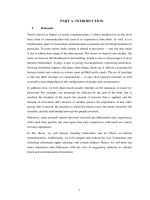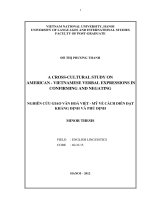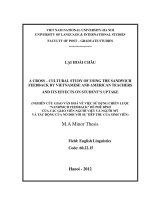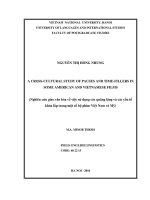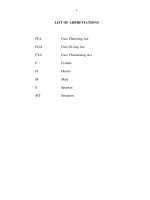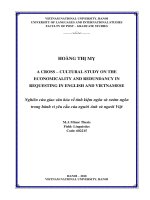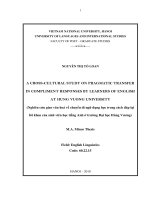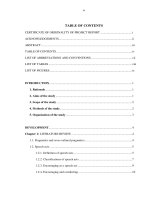NGHIÊN cứu GIAO văn hóa về CÁCH DIỄN đạt sự LO LẮNG TRONG TIẾNG ANH mỹ và TRONG TIẾNG VIỆT
Bạn đang xem bản rút gọn của tài liệu. Xem và tải ngay bản đầy đủ của tài liệu tại đây (930.08 KB, 76 trang )
ABSTRACT
In these days society, the prevalence of technology and internet has pushed
people from different continent close together. The need of intercultural interaction has
increased among those who learn foreign language as a second one. Expressing
emotions and feelings such as sadness, happiness or worry is the basic demands of
people. However, the way people from different countries express these emotions is
different from separated cultures. Originating from that fact, this study is conducted to
make the comparison between American and Vietnamese in the way they show their
worry. Furthermore, recently, there has appeared a new kind of entertainment, reality
show, which reflects exactly what people think and behave in their daily life. Coming
up with this phenomenon, the researcher makes up her mind to carry out the study
basing on the way contestants in two versions of The Voice in the US and in Vietnam
express their worry and nerve before each battle.
The paper will convey the preference in expressing a worry of both American
and Vietnamese contestants and then make the comparison between two cultures. In
the last part of the research, some implications for language teaching and learning, as
well as translating activities will be suggested.
TABLE OF CONTENTS
ii
TABLE OF CONTENTS PAGE
Statement of acceptance ii
Acknowledgement iii
Abstract iv
List of tables, figures viii
PART A- INTRODUCTION
I. Rationale for the study ……………………………… 2
II. Scope of the study 4
III. Objectives of the study 4
IV. Significance of the study 5
V. Research methodology 6
VI. Organization of the study 7
PART B- DEVELOPMENT
CHAPTER I: LITERATURE REVIEW AND THEORETICAL PRELIMINARIES
I. Overview of previous studies 8
II. Theoretical preliminaries 10
1.Speech acts 10
1.1 Definition 10
1.2 Classification 11
1.3 Expressing a worry as a speech act 13
2. Politeness and politeness principles in communication 14
2.1 Definition of politeness 14
iii
2.2 Positive and negative politeness 14
2.3 Politeness principles 14
3. Directness and indirectness in communication 15
3.1 Directness and indirectness 15
3.2 Some socio-cultural factors affecting the choice of directness and
indirectness in communication 16
4. Politeness and directness/indirectness in expressing a worry in
American English and Vietnamese 17
III. The context of what is in relation to the study 18
1. Reality show 18
2.The Voice- a successful reality show 19
2.1 Overview 19
2.2 Format description 20
2.3 Judging panel 21
CHAPTER II: FINDINGS AND DISCUSSION
I. Findings 23
II. Discussion 30
III. Concluding remarks about major cross-cultural similarities and differences
38
PART C- CONCLUSION
I. Summary of findings 41
II. Implications 42
iv
1. Implication for teaching and learning a foreign language and culture 43
1.1 Implications for teachers of language 43
1.2 Implications for learners of language 44
2. Implications for translation and interpretation 44
III. Limitations of the study 45
IV. Suggestions for further studies 45
BIBLIOGRAPHY
APPENDICES
Appendix 1: Utterances of American contestants in The Voice US
Appendix 2: Utterances of Vietnamese contestants in The Voice Vietnam
LIST OF TABLES, PICTURES AND FIGURES
v
PICTURES PAGE
Picture 2.1: Kaplan’s diagram about way of thinking
Picture 2.2: The international “The Voice” logo
Picture 2.3: Coaches of The Voice US season 1
Picture 2.4: Coaches of The Voice Vietnam season 1
15
20
21
22
FIGURES PAGE
Figure 3.1: Use of worry expressing strategies by American
contestants in The Voice US
Figure 3.2: Use of worry expressing strategies by Vietnamese
contestants in The Voice Vietnam
32
34
TABLES PAGE
Table 3.1: Use of worry expressing strategies by contestants in two
reality show: The Voice US and The Voice Vietnam
Table 3.2: Use of worry expressing strategies by American contestants
in The Voice US
31
31
vi
Table 3.3: Use of worry expressing strategies by Vietnam contestants
in The Voice Vietnam
Table 3.4: Use of strategy 1 by American contestants and Vietnamese
contestants
Table 3.5: Use of strategy 2 by American contestants and Vietnamese
contestants
Table 3.6: Use of strategy 3 by American contestants and Vietnamese
contestants
Table 3.7: Use of strategy 4 by American contestants and Vietnamese
contestants
Table 3.8: Use of strategy 5 by American contestants and Vietnamese
contestants
Table 3.9: Frequency of preferred worry expressing strategies for
American and Vietnamese contestants
34
36
37
37
37
38
40
vii
78
PART A - INTRODUCTION
I. Rationale for the study
“To have another language is to possess a second soul”
~Charlemagne~
The soul in this immortal saying of Charlemagne does not only refer to the
language itself, but also to culture of the country giving birth to that language because
culture can be seen as the soul of a country and language is the key to open the door of
that soul. In other words, it is undeniable that language plays an integral part of culture.
it is the mirror reflecting a nation’s culture and tradition, in which speech acts is
considered as means to express people’s feelings and emotions. In fact, many language
learners have encountered culture shocks or even the relationship break-up when they
communicate with foreigners owing to the misinterpretation of the message.
Nguyen Quang (1998,p.2) states that, “One cannot master a language without
profound awareness of its cultural background and in both verbal and non-verbal
communication, culture makes itself strongly felt”. According to him, in the
international environment, cultural disagreement is happened frequently. Let’s look at
a very simple example to have a general view about the issue:
- Minh: Oh my god! I’ll surely die this semester!
(Ôi trời ơi, kỳ này mình chết chắc rồi!)
- Tommy: ??? (being confused)
Obviously, the Vietnamese boy in the conversation does not have any
implications about the death in his saying. All he wants to do is to show his worry
about the bad result of this semester so that his friend can share with him.
78
Unfortunately for this boy, the way he adopts the hyperbole to express his feeling not
only fails to receive the sympathy from his buddy but also makes the Western friend
confused. The fact is that Eastern people in general always try to avoid mentioning
something that makes them feel uncomfortable by using meaning transferences.
Meanwhile, the Western culture prefers directly expressing their emotions or feelings.
Hence, the cultural differences can explain for the communication breakdown in many
situations like this.
It can be seen from the example that expressing a worry is one of the
speech acts that are easiest to lead to miscommunication between English learners and
native speakers due to the lack of cultural awareness. Nevertheless, while others as
wishing, or complaining are received much attention from scholars and researchers,
expressing a worry is ignored despite its frequent use. The problem here is that it is
quite difficult to do a study on the way people show their worry, as they tend to hide it
most of the time. With the prevalence of mass media nowadays, many reality shows
has become not only a source of entertainment for everyone but also a mirror reflecting
many aspects of people lives including feelings expression and communication. When
a reality show becomes popular worldwide and is franchised to different version, it
must be adapted flexibly so that it can be suitable to the audiences in the target nation.
That is also true to the reality show The Voice US version and Vietnamese one.
Therefore, the way contestants in these two versions express their worry is different.
Originating from the concern of the issue, the researcher think that it is better to
dig deeper into the way British and Vietnamese people expressing a worry by
analyzing two different versions of a famous reality show named The Voice US and
The Voice Vietnam. Only by doing that, can the researcher fulfill her hope of breaking
the iceberg between two cultures. All thing considered, the researcher comes up with
her paper‘s title “A cross- cultural communication study of expressing a worry in
English and Vietnamese”.
78
II. Scope of the study
Expressing human’s emotions and feelings is one of the issues attracting the
attention of linguists and experts. It requires any linguist who cares about this topic to
spend time and attempt so that he or she can approach the issue sufficiently. However,
owing to time constraint and the limited ability of the researcher, this paper only
focuses on the verbal form of worry expression in spite of the fact that nonverbal form
plays a significant role in showing an emotion.
Furthermore, due to the limited condition of the researcher and because she
would like to approach the speech act in a new way, the researcher plan to carry out the
survey basing on the feeling of contestant in one of the most famous reality show The
Voice. The study also conveys the response of contestants from both American and
Vietnamese versions. In addition, the scale of the research limits the survey in just 12
episodes of each version. The information collected from the survey will be analyzed
carefully and sincerely by the researcher.
III. Objectives of the study
This study aims at investigating into preferable way people from American and
Vietnam express their worry via two reality shows The Voice US and The Voice
Vietnam. Also, the study is conveyed with the intention of making the comparison
between contestants of two versions and the vary of worry expressions in English and
Vietnamese. Moreover, the researcher is interested in analyzing the data and then
giving useful suggestion for the communicators so that they can avoid unwanted
mistake.
Specifically, the paper is intended to address the following questions:
1) What are the preferable ways American contestants use to express a worry?
2) What are the preferable ways Vietnamese contestants use to express a worry?
78
3) What are the similarities and differences between contestants from the USA and
Vietnam in the preferable way of expressing a worry?
IV.Significance of the study
After being accomplished, the paper, first and foremost, is expected to be useful
for the researcher herself. By carrying on the study, the author hopes to raise her
awareness about cultural behaviors through language. After studying about expressing
a worry or nerve in English and Vietnamese, the researcher may have understanding
about not only worry expression but also other speech acts such as expressing anger or
happiness, and so on. This is particular meaningful for her future job when she luckily
has an opportunity to work as a translator or an interpreter for a multinational
organization. With equipped knowledge, she can avoid unwanted culture shock or
misinterpreting when communicating with foreigners, especially the Westerners.
More than that, the paper is hoped to benefit the English learners as well as any
people who are interested in investigating into various aspects of speech acts in general
and worry expressions in particular. To some extent, the author would be very happy to
contribute her small attempt to the teaching and learning English at the university,
especially to the intercultural communication course.
With the researcher’s ambition investigating the general understanding about the
differences and similarities between two cultures in the way they expressing their
worry, the paper, once fulfilled, can serve as a source of reference for those who are
fond of digging deeper into the issue and language learners. Finally, the paper is hoped
to play as a contributor for narrowing the cultural distance between two countries.
V. Research methodology
78
Selection of subject
Originating from the idea of studying the similarities and differences of a worry
expression between American and Vietnamese as well as their preferable, the
researcher find out that only in last competition like reality television, can contestants’
worry be expressed clearly. Therefore, she comes up to the decision to employ 12
episodes of The Voice US and other 12 episodes of The Voice Vietnam including the
final and semi-final cycle. The chosen samples are all from the latest series in 2012
season.
Research methodology
Regarding the purpose of this study, the researcher has found that quantitative is
the most feasible method to deal with the research problems. It is because, in the social
sciences, quantitative refers to the systematic empirical investigation of quantitative
properties and phenomena and their relationships. The objective of quantitative
research is to develop and employ mathematical model, theories and hypotheses
pertaining to phenomena.
Besides, qualitative method is required in different academic disciplines,
traditionally in the social sciences, but also in market research and further contexts.
The qualitative aims to gather an in-depth understanding of human behavior and the
reasons that govern such behavior.
Data collection procedures
The data collection procedure is divided into two main phases as follow:
Phase 1
This phase includes the time researcher spend collecting and watching 12
episodes of TVUS and other 12 ones of TVVN. In other words, the researcher will
watch all episodes in both version of the latest season and choose the 12 best form each
version.
78
Phase 2
In this phase, researcher watches the program in detail and takes notes all the
transcripts of the ideas of contestants which contain worrying emotion.
Simultaneously, prominent examples of each way of showing emotion are noted down
to exemplify the researcher’ later analysis.
Data analysis procedures
To answer the research question stated above, data analysis will be carried out.
Information from the participants, after being identified, will be categorized. Certain
theoretical models presented in Literature review, and their combinations will be
applied as well. Some calculation will be made to figure out the most preferable
response people from each country like to use.
VI. Organization of the study
The paper includes three main parts as follows:
Part A- Introduction presents the rationale, the aims and objectives, the
significance, the research methodology and the scope of the study.
Part B- Development is divided into 3 chapters:
Chapter I: Literature review provides readers with theoretical
backgrounds for the paper. Specifically, key concepts and terms related to the topic of
the study, such as speech acts, politeness or reality show would be explained in
different views of language scholars and experts.
Chapter II: Findings and Discussion analyzes the collected data in
order to answer the above research questions.
Part C- Conclusion summarizes the major findings, the limitations of the study
as well as recommendations for future research.
78
PART B – DEVELOPMENT
CHAPTER I: LITERATURE REVIEW AND
THEORETICAL PRELIMINARIES
This chapter represents some theoretical preliminaries and background
knowledge, basing on which the study is conducted. The chapter has two-fold intent.
Firstly, it deals with some academic terminologies and theories as the speech acts,
politeness and directness in worry expressing in communication. Secondly, the chapter
provides the common understanding about reality show in general and The Voice-one
of the most successful reality shows all over the world.
I. Overview of previous studies
In the modern society when the world is becoming smaller with the prevalence
of technology devices and high-quality transportation, people from different continents
have more chances to exchange business activities as well as cultural beauty to each
other. In this context, the demand for interacting and communicating cross-cultural is
increasing. As stated in the previous chapter, language is the reflection of a nation’s
culture, which enables a person, regardless to his nationality, to express himself. All of
people’s feelings in daily routine can be shown through their cultural behaviors or in
other words, the speech acts. Thus, speech acts and their variation have attracted a lot
of attention from both experts and those who are keen on language and culture
studying.
In the international field, originating from the need of investigating cultural
behavior of people through languages, many linguists spent time and efforts exploring
the first speech acts theories. Since the 1960s of the twenty century, John L. Austin, a
British philosopher of language, developed his observation of the relation between
78
people’s behaviors and language to speech acts theory through his work titled “How to
do things with words”. Since then, many other specialists and linguists followed Austin
to build and complete the theory of speech acts and many relating issues such as
politeness or directness. Specifically, there can count for “Speech acts” (1969) by
Searle; “Universals in language usage: Politeness phenomenon” (1978) by Brown and
Levinson; “The Logic of Politeness: or Minding your P’s and Q’s” (1973) by Lakoff;
“Linguistic communication and speech acts” (1984) by Back and Harnish; or
“Understanding Ways: Communicating between cultures” (1994) by O’Sullivivan.
These works and studies put the first bricks to the modern philosophy of language in
general and the cross-cultural studies in particular.
In the territory of Vietnam, intercultural communication studies on American-
Vietnamese interaction were somehow limited before the renovation as the political
and diplomatic policies of the countries. Yet, with an open policy and the
normalization in diplomatic relation between two countries since 1995, Vietnamese
students were offered a lot of opportunities to study in the US through scholarships or
exchange students programs. Therefore, the number of studies and researches on the
cross-cultural communication and speech acts has been dramatically increasing.
Among these studies, there are noticeably the studies conducted by two linguists from
the University of Languages of International Studies, VNU, Pr. Nguyen Quang with
“Intercultural Communication” (1998) and Pr. Ngo Huu Hoang with “A cross-
cultural study of Thanking and responding to thanks in English and Vietnamese in
comparison and contrast” (1998). Besides, at ULIS, VNU, many undergraduates have
chosen speech acts as their subject to study in BA graduation papers, including
“complaining and responding a complaint” (Giang, N.H, 2012), “refusing an
invitation” (Loan, N.T, 2010), “giving congratulation” (Linh,N.T.H, 2007),
“promising” (Chung, T.T, 2004), so on and so forth. All of these paper focus on the
similarities and differences between English and Vietnamese.
78
Although the abundance of approaches to speech acts theory and language
behavior studies, it is noticeable that there has been no study or research on worry and
expressing a worry as a speech act so far. With the hope to investigate a new form of
speech acts which illustrates people’s feelings, the research come up with the idea of
studying the way people in English and Vietnamese expressing their worry and nerve.
II. Theoretical preliminaries
1. Speech acts
1.1. Definition
In general, speech acts are acts of communication. To communicate is to
express a certain attitude, and the type of speech act being performed corresponds to
the type of attitude being expressed. For example, a statement expresses a belief, a
request expresses a desire, and an apology expresses regret. As an act of
communication, a speech act succeeds if the audience identifies, in accordance with the
speaker's intention, the attitude being expressed.
In linguistics, an utterance defined in terms of a speaker's intention and the
effect it has on a listener. Speech act theory, as introduced by Oxford philosopher J.L.
Austin (1962), was further developed by many other scientists such as the American
philosopher J.R. Searle (1969,1975), Bach, K.& Harnish,R. (1984) and so on.
J.L Austin (1962) gives some ideas about speech acts as:
… in order to explain what can go wrong with statements we cannot just
concentrate on the proposition involved (whatever that is) as has been done
traditionally. We must consider the total situation in which the utterance is
issued the total speech-act if we are to see the parallel between statements and
performative utterances, and how each can go wrong. So the total speech act in
the total speech situation is emerging from logic piecemeal as important in
78
special cases: and thus we are assimilating the supposed constative utterance to
the perfomative." (J. L. Austin, 1975)
From the origination of Austin, speech act theory has been popularized and
varied in conceptualization and verbalization across culture and language.
Some speech acts, however, are not primarily acts of communication and have
the function not of communicating but of affecting institutional states of affairs. They
can do so in either of two ways. Some officially judge something to be the case, and
others actually make something the case. Those of the first kind include judges' rulings,
referees' calls and assessors' appraisals, and the latter include include sentencing,
bequeathing and appointing. Acts of both kinds can be performed only in certain ways
under certain circumstances by those in certain institutional or social positions.
1.2. Classification
The father of speech act theory, John L.Austin, categorizes speech acts as three
main types: locutionary (acts), illocutionary (force) and perlocutionary.
i. A locutionary act is the act of saying something in the full sentence of “say”
Ex: Nice weather today?”
"In performing a locutionary act we shall also be performing such an act as:
asking or answering a question;
giving some information or an assurance or a warning;
announcing a verdict or an intention;
pronouncing sentence;
making an appointment or an appeal or a criticism;
making an identification or giving a description;
and the numerous like."
78
(John L. Austin, How to Do Things With Words, 2nd ed. Harvard Univ. Press, 1975)
F. Parker and K. Riley (1994) defines:
"A locutionary act is the act of using a referring expression (e.g., a noun phrase)
and apredicating expression (e.g., a verb phrase) to express a proposition. For
instance, in the utterance You should stop smoking, the referring expression
is you and the predicating expression is stop smoking. . . .”
ii. An illocutionary act is an act performed in saying something, the act identified
by the explicit performative.
For example:
Kenneth Parcell: I'm sorry, Mr. Jordan. I'm just overworked. With my
page duties and being Mr. Donaghy's assistant, there's not enough hours
in the day.
Tracy Jordan: I'm sorry about that. But just let me know if there's any
way I can help.
Kenneth: Actually, there is one thing. . . .
Tracy: No! I was just saying that! Why can't you read human facial
cues?
(Matthew Hubbard, "Cutbacks," 30 Rock, April 9, 2009)
The illocutionary act is performed through the communicative force of an
utterance. We may utter a sentence to make statement, an offer or for some other
communicative purposes.
iii. A perlocutionary act is the act of an action or state of mind brought about by, or
as a consequence of, saying something.
Searle (1975,p.60) also develops the theory of the distinction between direct and
indirect speech act “which depends on a recognition of the intend perlocutionary effect
78
of an utterance on a particular occasion. Indirect speech act are cases in which one
illocutionary act is performed indirectly by way of performing another”
According to Searle, speech act can be grouped into some main types:
i. Expressives: the expression of joys, disappointment, likes and dislikes. The
form of expressives may be diverse even within one language.
ii. Representatives: speech act can be judged for truth value. Representatives may
vary in terms of how hedged or aggravated the assertion might be. These
variations are often expressed by the use of modal words.
iii. Directives: the acts which get people something. Their function can be realized
by a wide range of forms like imperative sentences, questions, or even statement
whose illocutionary force is that of directive.
iv. Commissives: Acts that represent a promise or refusal for action.
v. Declaratives: acts that bring about a new state of being
1.3 Expressing a worry as a speech act
A worry or nerve is the feeling of unsafe or unprotected. People may worry
about something going to happen to them, for example a contest or an examination or a
unwanted events. Although everyone need to express the feeling of worry, the way
people experience this emotion and the way they show out of it is different and varies
from culture to culture. As the classification of speech acts mentioned above, it can be
seen that a worry expressing is an expressive act in which the speaker shows their
felling directly or indirectly relying on their cultural control.
According to the classification of Austin, expressing a worry undoubtingly
belongs to the illocutionary act with the illocutionary force of expressing emotion. An
worry can be expressed differently in terms of verbal and non-verbal communication in
different cultures and traditions.
78
2. Politeness and politeness principles in communication
2.1 Definition of politeness
Politeness is the way people treat others. I can be seen as the basic to the
production of social order, and a precondition of human co-operation (Levinson, 1987).
According to Oxford Advanced learner, politeness is “having or showing good
manners and respect for the feelings of others”. Many theories have developed to give
the basic understanding about politeness.
Richard, J.et al (1998,p.281) claims that politeness means (a) how languages
express the social distance between speakers and their different role relationship; (b)
how face –work, that is, the attempt to establish, maintain and save face during
conversation.
2.2 Positive and Negative politeness
The concept of politeness can be understood flexibly through various cultures.
However, linguists categorize it into positive politeness and negative politeness.
i. Positive politeness: referring to the person’s negative face which tends to show
deference, emphasize the importance of the other’s time or concern, an apology
for the imposition or interruption.
ii. Negative politeness: relating to the person’s positive face which tends to show
solidarity, emphasize both speakers want the same thing and that they have a
common goal (Yule, 1996, p.62).
2.3 Politeness principles
Being polite is an action that requires the speakers show his respect to the
partners. However, to become polite in all situations is far from easy. Robin Lakoff
(1990,p.38) make principles of politeness so that people can follow to “save their
face”:
78
• Don’t impose: avoiding or asking permission or apologizing when doing
something that others don’t want to do.
• Offer options: expressing oneself in such a way that one’s opinions or request
can be ignored without being contradicted or rejected.
• Encourage feelings of Camarderie: assuming that with a close friend, one
should be able to discuss anything. Almost any topic of conversation is a fair
game.
3 Directness and indirectness in communication
3.1 Directness and Indirectness
When expressing any emotion or feeling status, different person tends to use
different way, its may be direct or indirect expressing. The fact is that each culture has
their own way of thinking, which is illustrated in Kaplan’s diagram:
Picture 2.1: Kaplan’s diagram about way of thinking
From the diagram, it can be seen that English people often express their thought
directly while Oriental people in general and Vietnamese in particular have tendency of
using indirect saying.
78
3.2 Some Socio- cultural factors affecting the choice of directness and
indirectness in communication
Nguyen Quang, 1998, p.112 identifies 12 factors governing the choice of direct
and indirect in communication that are translated into English by Ngo Huu Hoang in
his MA thesis as as follows:
i. Age: the old tends to be more indirect than the young does
ii. Sex: female prefers indirect expression
iii. Residence: The rural population tends to use more ID than the urban ones
iv. Mood: while angry, people tend to use more ID
v. Occupation: those who do social sciences tend to use more ID than those who
do natural sciences
vi. Personality: the extroverted tend to use more ID than the introverted
vii. Topic: while referring to a subtle topic, a taboo, people usually opt for ID
viii. Place: when at home, people tend to use more D than when they are at another
places
ix. Communicative environment: when in an informal climate, people tend to
express more directly
x. Social distance: those who have closer relationship tend to talk in a more
directly
xi. Time pressure: when in a hungry, people are likely to use an indirect expression
xii. Position: when in a superior position, people tend to use more D to their
inferiors
78
4. Politeness and directness/indirectness in expressing a worry in
American English and Vietnamese
As discussed earlier, expressing a worry is included in language activities and
exists in communication as an inevitable need. Unlike angry, sad or happy emotions,
the degree of politeness or directness of a worry expression cannot be figured out
clearly. In other words, the border of the difference in showing worry feeling between
American and Vietnamese people is quite fragile. However, because of belonging to
two spectrum of the globe, each culture preserves their own beliefs and values, not
except for the way they showing their concern and worry.
In most case, both American and Vietnamese have their needs of expressing
feelings in general and worry in particular. They tend to share their concern with
someone that they are familiar or who makes them feel safe and sound, someone that
they can believe. However, the way each culture shows a worry is somehow different.
In one hand, Westerner people are believed to highly appreciate individualism
and privacy, follow negative politeness. They are generally more direct, open and freer
to express their feelings. They will not try to mask their emotion and much less
concerned with other face. In worry expression, the American try to share their
problem directly with the hope of finding out the solution to the problem. To them,
honesty is usually more important than preserving harmony in interpersonal
relationships.
In the other hand, Vietnamese, as part of the Oriental culture, highly respect
positive politeness. They tend to be more preserved. The Vietnamese are always polite
even if only superficially. To them, a personal worry should be kept in their mind and
if they want to share it to another, that person must be their relative or close friend.
People always try to hide their true feeling behind a smile. The way a Vietnamese
person talking about their problem is also identical. Indirectness and politeness is
78
highly valued in this society. Instead of going straight into the problem, they keep
going around and around.
In conclusion, worry expressing is American and Vietnamese appears different
in different situations. Thus, culture shocks are highly potential if communicators are
unaware of the differences of cultural values, norms of politeness and directness. To
enhance the success of communication, there appears no other way except that
communication participants get themselves fully provided with the knowledge of the
cultural differences.
III. The context of what is in relation to the study
1. Reality show
Reality show is a new term appearing when the mass media and entertainment
explode. When people ‘quality of life is improved, most of them would like to enjoy
more programs with high intellectual value. In order to meet the demand of the
majority of audiences, producers rapidly think about the programs that not only
entertain the hardest audiences but also give them the real experiences. The feelings
that contestants and judge panels experience are also the feeling that people can have in
true life.
If we surf on the internet with the key word is reality show definition or what is
reality show?, we can find out many sources providing the definition or understanding
about these concept. In Wikipedia, the term reality show is defined quite detail and
easy to catch as a television programming genre that presents unscripted and
humorous situations, documents actual events and usually features ordinary people
instead of professional actors. Reality television offers viewers a glimpse into the lives
of people that might otherwise not be seen. It can also be seen as a platform for the
subjects of the programs, to clear up misconceptions, and show their story or
78
struggle. Although Wikipedia is considered an unauthorized online encyclopedia, it
seems to be successful in offering a very detailed and comprehensive definition.
Besides, according to Collins Cobuild Advanced Learner’s English Dictionary,
a reality show is a type of television programming that aims to show how ordinary
people behave in everyday life, or in situations, often created by programme makers,
which are intended to present everyday life. With this clear and concise definition, it is
clear that reality show can perfectly reflect life routine and behavior of people in
different situation, including showing a worry.
2. The Voice- a successful reality show
2.1 Overview
The Voice is a singing competition held in form of a reality talent show on NBC
television network. Based on the reality singing competition The Voice of Holland, the
series was created by Dutch television producer John de Mol and is executive by Mark
Burnett. The original name of this show is The Voice of Holland (TVOH) but when is
“imported” into other countries, it is shortened to The Voice with name of each
country, i.e The Voice US or The Voice Vietnam.
The Voice is firstly broadcasted in Netherlands in 17
th
of September 2010 and
The USA is the first nation buying its copyright. So far, The Voice has experienced
three seasons in Netherlands and USA.
The Voice logo features a microphone in a “V” gesturing hand with the titled
lettering of “The Voice”. This also represent the victory that is worth for the talent of
the winner. It is the international logo of the show.
78
Picture 2.2: The international “The Voice” logo
2.2 Format description
The series consists of three phases: a blind audition, a battle phase, and live
performance shows. Four judges/coaches, all noteworthy recording artists, choose
teams of contestants through a blind audition process. Each judge has the length of the
auditioner's performance (about ninety seconds) to decide if he or she wants that singer
on his or her team. If two or more judges want the same singer (as happens frequently),
the singer has the final choice of coach.
Each team of singers is mentored and developed by its respective coach. In the
second stage, called the battle phase, coaches have two of their team members battle
against each other directly by singing the same song together, with the coach choosing
which team member to advance from each of individual "battles" into the first live
round. Within that first live round, the surviving acts from each team again compete
head-to-head, with public votes determining one of two acts from each team that will
advance to the final six, while the coach chooses which of the remaining three acts
comprises the other performer remaining on the team.
